项目简介:
最近在做一个有趣的项目,需要对某网站的验证码进行识别。
某网站验证码如图: ,像素大小:30x106x3
,像素大小:30x106x3
通过人工标记的验证码数量约为1000条: 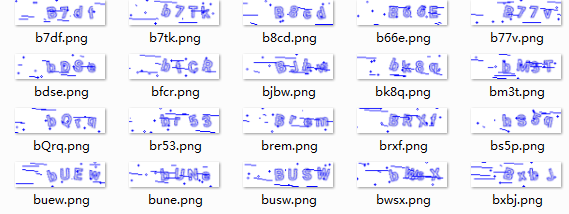
现在需要通过机器学习方法来进行识别新验证码,设计的方案有如下四种:
-
KNN + 原样本图;需要对图像去噪、二值化、切割等处理。对数据量要求没CNN高。
-
CNN + 原样本图;缺点:样本少,优点:数据质量高。
-
CNN + 构造类似验证码图;缺点:构造验证码是否和和原验证码类似,需要较高技术;优点:样本多。
-
CNN + 单字符样本图;优点:输入图像小,且输出类别少。
-
其他:如用pytesseract+去噪+二值化等,简单尝试了一下准确率很低,pass掉了
方案一:KNN + 原样本图
步骤:
-
去噪: 原图:

class NoiseDel(): #去除干扰噪声 def noise_del(self,img): height = img.shape[0] width = img.shape[1] channels = img.shape[2] # 清除四周噪点 for row in [0,height-1]: for column in range(0, width): if img[row, column, 0] == 0 and img[row, column, 1] == 0: img[row, column, 0] = 255 img[row, column, 1] = 255 for column in [0,width-1]: for row in range(0, height): if img[row, column, 0] == 0 and img[row, column, 1] == 0: img[row, column, 0] = 255 img[row, column, 1] = 255 # 清除中间区域噪点 for row in range(1,height-1): for column in range(1,width-1): if img[row, column, 0] == 0 and img[row, column, 1] == 0: a = img[row - 1, column] # 上 b = img[row + 1, column] # 下 c = img[row, column - 1] # 左 d = img[row, column + 1] # 右 ps = [p for p in [a, b, c, d] if 1 < p[1] < 255] # 如果上下or左右为白色,设置白色 if (a[1]== 255 and b[1]== 255) or (c[1]== 255 and d[1]== 255): img[row, column, 0] = 255 img[row, column, 1] = 255 # 设置灰色 elif len(ps)>1: kk = np.array(ps).mean(axis=0) img[row, column, 0] = kk[0] img[row, column, 1] = kk[1] img[row, column, 2] = kk[2] else: img[row, column, 0] = 255 img[row, column, 1] = 255 return img # 灰度化 def convert2gray(self,img): if len(img.shape) > 2: gray = np.mean(img, -1) # 上面的转法较快,正规转法如下 # r, g, b = img[:,:,0], img[:,:,1], img[:,:,2] # gray = 0.2989 * r + 0.5870 * g + 0.1140 * b return gray else: return img # 二值化 def binarizing(self,img,threshold, cov=False): w, h = img.shape if cov: for y in range(h): for x in range(w): if img[x, y] > threshold: img[x, y] = 0 else: img[x, y] = 255 else: for y in range(h): for x in range(w): if img[x, y] < threshold: img[x, y] = 0 else: img[x, y] = 255 return img去噪后:

-
切分最小图
def cut_box(img,resize=(64,18)): # 灰度,二值化 image = nd.convert2gray(img) image = nd.binarizing(image,190, True) image = Image.fromarray(image) img0 = Image.fromarray(img) box = image.getbbox() box1 = (box[0]-2,box[1]-2,box[2]+2,box[3]+2) image = img0.crop(box1) image = image.resize(resize) return np.array(image)切分后:

-
分割字符串:
def seg_img(img): h,w,c = img.shape d = int(w/4) img_list = [] for i in range(4): img_list.append(img[:,i*d:(i+1)*d]) return img_list分割后:
 ,
, ,
, ,
,
经过对1000张标记好的图片进行处理,得到各个字母数字对应的单字符图片数据集:
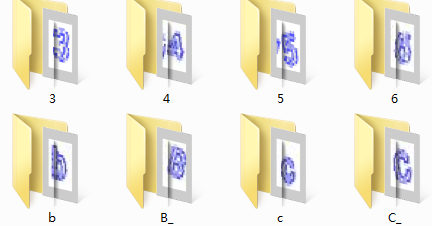
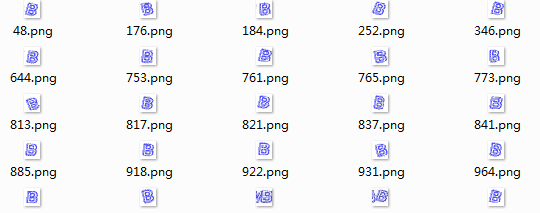
-
KNN训练及预测:
对图像进行灰度处理
import os from PIL import Image import numpy as np from cut_prc import cut_box,seg_img from noise_prc import NoiseDel from sklearn import neighbors, svm,tree,linear_model from sklearn.model_selection import train_test_split nd = NoiseDel() def predict_img(img, clf): text = '' image = nd.noise_del(img) image = cut_box(image) image_list = seg_img(image) for im in image_list: im = nd.convert2gray(im) im = im.reshape(-1) c = clf.predict([im,])[0] text += c return text if __name__=="__main__": # 获取训练数据 path = 'data/png_cut' classes = os.listdir(path) x = [] y = [] for c in classes: c_f = os.path.join(path, c) if os.path.isdir(c_f): files = os.listdir(c_f) for file in files: img = Image.open(os.path.join(c_f, file)) img = np.array(img) img = nd.convert2gray(img) img = img.reshape(-1) x.append(img) y.append(c.replace('_','')) x = np.array(x) y = np.array(y) # 拆分训练数据与测试数据 x_train, x_test, y_train, y_test = train_test_split(x, y, test_size=0.02) # 训练KNN分类器 clf = neighbors.KNeighborsClassifier(n_neighbors=5) clf.fit(x_train, y_train) # 预测测试集 test_pre = clf.predict(x_test) print("KNN accuracy score:", (test_pre == y_test).mean()) # 预测新样本集 newpath = 'data/png_new' newfiles = os.listdir(newpath) for file in newfiles: image = Image.open(os.path.join(newpath,file)) image = np.array(image) text = predict_img(image, clf) print(text) # # 训练svm分类器 # clf = svm.LinearSVC() ### # clf.fit(x_train, y_train) # # test_pre = clf.predict(x_test) # print("SVM accuracy score:", (test_pre == y_test).mean()) # # # 训练dt分类器 # clf = tree.DecisionTreeClassifier() # clf.fit(x_train, y_train) # # test_pre = clf.predict(x_test) # print("DT accuracy score:", (test_pre == y_test).mean()) # # # 训练lr分类器 # clf = linear_model.LogisticRegression() ### t # clf.fit(x_train, y_train) # # test_pre = clf.predict(x_test) # print("LR accuracy score:", (test_pre == y_test).mean()) -
运行结果:(单个字符预测精度),KNN最高,达到80%,而SVM,DT,LR均较低
KNN accuracy score: 0.8170731707317073 SVM accuracy score: 0.6341463414634146 DT accuracy score: 0.4878048780487805 LR accuracy score: 0.5975609756097561KNN 预测图片:

mHFM crdN wa5Y swFn ApB9 eBrN rJpH fd9e kTVt t7ng
方案二:CNN+原样本图
步骤:
-
处理样本数据1020张图,灰度化 ,像素大小30*106,标签为小写字符(标记人员太懒了);
-
拆分数据:train:80%, val:20%
-
网络模型:输入数据维度30*106,采用三层CNN,每一层输出特征维数分别:16,128,16,FC层输出 512维,最后全连接输出4x63,每行代表预测字符的概率。
-
结果:验证集字符准确率最高到达了50%
方案三: CNN+ 构造类似验证码图
第三方库生成的验证码如下所示:
from captcha.image import ImageCaptcha # pip install captcha
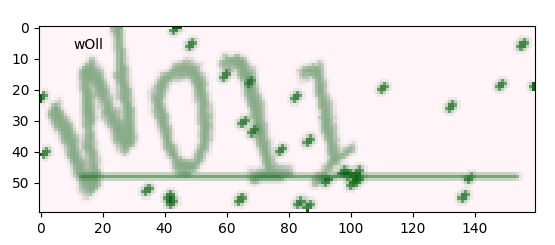
下载相应的字体(比较难找),然后修改第三方库中image.py文件,修改了第三方库后生成的验证码: 
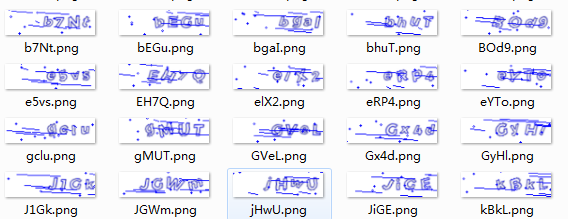
效果和我们需要的验证码比较相似了,但还是有区别。
fonts = ["font/TruenoBdOlIt.otf", "font/Euro Bold.ttf", "STCAIYUN.TTF"]
image = ImageCaptcha(width=106, height=30,fonts=[fonts[0]],font_sizes=(18,18,18))
captcha = image.generate(captcha_text)
image.py
略..
采用自动生成的验证码,用于CNN训练模型,训练和验证精度都达到了98%,但测试原图1000样本的字符精度最高只有40%,由此可见,生成的验证码还是与目标验证码相差较大。
step: 18580/20000... loss: 0.0105...
step: 18600/20000... loss: 0.0121...
step: 18600/20000... --------- val_acc: 0.9675 best: 0.9775 --------- test_acc2: 0.4032
step: 18620/20000... loss: 0.0131...
step: 18640/20000... loss: 0.0139...
step: 18660/20000... loss: 0.0135...
step: 18680/20000... loss: 0.0156...
step: 18700/20000... loss: 0.0109...
step: 18700/20000... --------- val_acc: 0.9625 best: 0.9775 --------- test_acc2: 0.3995
方案四: CNN+ 字符样本集
由于只有1000样本,直接经过CNN端到端输出字符序列,很难到达精度要求,为此方案三采用自动创建样本集的方法,但样本质量和真实样本之间存在差异,导致预测不准。为此,将原1000样本进行分割处理为单字符集,样本数量约4000左右,且输入维度减小很多,同时输出类别也减小很多。分析后改方案有一定可行性。
样本集处理与之前KNN一样: 经过对1000张标记好的图片进行处理,得到各个字母数字对应的单字符图片数据集: 

import os
import numpy as np
import tensorflow as tf
from PIL import Image
from noise_prc import NoiseDel
from cut_prc import cut_box,seg_img
from sklearn.model_selection import train_test_split
from sklearn.preprocessing import LabelBinarizer
nd = NoiseDel()
class Config():
file_name = 'char_02' # 存放模型文件夹
w_alpha = 0.01 #cnn权重系数
b_alpha = 0.1 #cnn偏执系数
image_h = 18
image_w = 16
cnn_f = [16,32,32,512] # [cov1输出特征维度,cov2输出特征维度,cov3输出特征维度,全连接层输出维度]
max_captcha = 1 #验证码最大长度
char_set_len = 50 #字符集长度
lr = 0.001
batch_size = 32 # 每批训练大小
max_steps = 200000 # 总迭代batch数
log_every_n = 20 # 每多少轮输出一次结果
save_every_n = 100 # 每多少轮校验模型并保存
class Model():
def __init__(self, config):
self.config = config
self.input()
self.cnn()
# 初始化session
self.saver = tf.train.Saver()
self.session = tf.Session()
self.session.run(tf.global_variables_initializer())
def input(self):
self.X = tf.placeholder(tf.float32, [None, self.config.image_h * self.config.image_w])
self.Y = tf.placeholder(tf.float32, [None, self.config.max_captcha * self.config.char_set_len])
self.keep_prob = tf.placeholder(tf.float32) # dropout
# 两个全局变量
self.global_step = tf.Variable(0, trainable=False, name="global_step")
self.global_loss = tf.Variable(0, dtype=tf.float32, trainable=False, name="global_loss")
def cnn(self):
x = tf.reshape(self.X, shape=[-1, self.config.image_h , self.config.image_w, 1])
# 3 conv layer
w_c1 = tf.Variable(self.config.w_alpha * tf.random_normal([3, 3, 1, self.config.cnn_f[0]]))
b_c1 = tf.Variable(self.config.b_alpha * tf.random_normal([self.config.cnn_f[0]]))
conv1 = tf.nn.relu(tf.nn.bias_add(tf.nn.conv2d(x, w_c1, strides=[1, 1, 1, 1], padding='SAME'), b_c1))
conv1 = tf.nn.max_pool(conv1, ksize=[1, 2, 2, 1], strides=[1, 2, 2, 1], padding='SAME')
conv1 = tf.nn.dropout(conv1, self.keep_prob)
w_c2 = tf.Variable(self.config.w_alpha * tf.random_normal([3, 3, self.config.cnn_f[0], self.config.cnn_f[1]]))
b_c2 = tf.Variable(self.config.b_alpha * tf.random_normal([self.config.cnn_f[1]]))
conv2 = tf.nn.relu(tf.nn.bias_add(tf.nn.conv2d(conv1, w_c2, strides=[1, 1, 1, 1], padding='SAME'), b_c2))
conv2 = tf.nn.max_pool(conv2, ksize=[1, 2, 2, 1], strides=[1, 2, 2, 1], padding='SAME')
conv2 = tf.nn.dropout(conv2, self.keep_prob)
w_c3 = tf.Variable(self.config.w_alpha * tf.random_normal([3, 3, self.config.cnn_f[1], self.config.cnn_f[2]]))
b_c3 = tf.Variable(self.config.b_alpha * tf.random_normal([self.config.cnn_f[2]]))
conv3 = tf.nn.relu(tf.nn.bias_add(tf.nn.conv2d(conv2, w_c3, strides=[1, 1, 1, 1], padding='SAME'), b_c3))
conv3 = tf.nn.max_pool(conv3, ksize=[1, 2, 2, 1], strides=[1, 2, 2, 1], padding='SAME')
conv3 = tf.nn.dropout(conv3, self.keep_prob)
# Fully connected layer
h =tf.cast( conv3.shape[1],tf.int32)
w = tf.cast( conv3.shape[2],tf.int32)
f = tf.cast( conv3.shape[3],tf.int32)
w_d = tf.Variable(self.config.w_alpha * tf.random_normal([h* w * f, self.config.cnn_f[3]]))
b_d = tf.Variable(self.config.b_alpha * tf.random_normal([self.config.cnn_f[3]]))
dense = tf.reshape(conv3, [-1, w_d.get_shape().as_list()[0]])
dense = tf.nn.relu(tf.add(tf.matmul(dense, w_d), b_d))
dense = tf.nn.dropout(dense, self.keep_prob)
w_out = tf.Variable(self.config.w_alpha * tf.random_normal([self.config.cnn_f[3], self.config.max_captcha * self.config.char_set_len]))
b_out = tf.Variable(self.config.b_alpha * tf.random_normal([self.config.max_captcha * self.config.char_set_len]))
out = tf.add(tf.matmul(dense, w_out), b_out)
# out = tf.nn.softmax(out)
# loss
# loss = tf.reduce_mean(tf.nn.softmax_cross_entropy_with_logits(output, Y))
self.loss = tf.reduce_mean(tf.nn.sigmoid_cross_entropy_with_logits(logits=out, labels=self.Y))
# optimizer 为了加快训练 learning_rate应该开始大,然后慢慢衰
self.optimizer = tf.train.AdamOptimizer(learning_rate=self.config.lr).minimize(self.loss,global_step=self.global_step)
predict = tf.reshape(out, [-1, self.config.max_captcha, self.config.char_set_len])
self.max_idx_p = tf.argmax(predict, 2)
max_idx_l = tf.argmax(tf.reshape(self.Y, [-1, self.config.max_captcha, self.config.char_set_len]), 2)
correct_pred = tf.equal(self.max_idx_p, max_idx_l)
self.accuracy = tf.reduce_mean(tf.cast(correct_pred, tf.float32))
def load(self, checkpoint):
self.saver.restore(self.session, checkpoint)
print('Restored from: {}'.format(checkpoint))
def train(self, get_next_batch, model_path, x_train, y_train, x_test, y_test):
with self.session as sess:
while True:
batch_x, batch_y = get_next_batch(x_train, y_train,self.config.batch_size)
_, loss_ = sess.run([self.optimizer, self.loss], feed_dict={self.X: batch_x, self.Y: batch_y, self.keep_prob: 0.75})
if self.global_step.eval() % self.config.log_every_n == 0:
print('step: {}/{}... '.format(self.global_step.eval(), self.config.max_steps),
'loss: {:.4f}... '.format(loss_))
# 每100 step计算一次准确率
if self.global_step.eval() % self.config.save_every_n == 0:
# batch_x_test, batch_y_test = get_next_batch(100)
acc = sess.run(self.accuracy, feed_dict={self.X: x_test, self.Y: y_test, self.keep_prob: 1.})
print('step: {}/{}... '.format(self.global_step.eval(), self.config.max_steps),
'--------- acc: {:.4f} '.format(acc),
' best: {:.4f} '.format(self.global_loss.eval()))
if acc > self.global_loss.eval():
print('save best model...')
update = tf.assign(self.global_loss, acc) # 更新最优值
sess.run(update)
self.saver.save(sess, os.path.join(model_path, 'model'), global_step=self.global_step)
if self.global_step.eval() >= self.config.max_steps:
#self.saver.save(sess, os.path.join(model_path, 'model_last'), global_step=self.global_step)
break
def test(self, batch_x_test):
sess = self.session
max_idx_p = sess.run(self.max_idx_p, feed_dict={self.X: batch_x_test, self.keep_prob: 1.})
return max_idx_p
def get_next_batch( train_x, train_y, batch_size=32):
n = train_x.shape[0]
chi_list = np.random.choice(n, batch_size)
return train_x[chi_list],train_y[chi_list]
def img_cut_to_arry(img):
imgs = []
image = nd.noise_del(img)
image = cut_box(image)
image_list = seg_img(image)
for im in image_list:
im = nd.convert2gray(im)
im = im.reshape(-1)
imgs.append(im)
return imgs
if __name__=="__main__":
# nd = NoiseDel()
# 获取训练数据
path = 'data/png_cut'
classes = os.listdir(path)
x = []
y = []
for c in classes:
c_f = os.path.join(path, c)
if os.path.isdir(c_f):
files = os.listdir(c_f)
for file in files:
img = Image.open(os.path.join(c_f, file))
img = np.array(img)
img = nd.convert2gray(img)
img = img.reshape(-1)
x.append(img)
y.append(c.replace('_',''))
lb = LabelBinarizer()
ly = lb.fit_transform(y) # one-hot
x = np.array(x)
y = np.array(ly)
# 拆分训练数据与测试数据
x_train, x_test, y_train, y_test = train_test_split(x, y, test_size=0.02)
# 创建模型目录
model_path = os.path.join('c_models', Config.file_name)
if os.path.exists(model_path) is False:
os.makedirs(model_path)
# 加载上一次保存的模型
model = Model(Config)
checkpoint_path = tf.train.latest_checkpoint(model_path)
if checkpoint_path:
model.load(checkpoint_path)
# train and val
print('start to training...')
model.train(get_next_batch, model_path, x_train,y_train, x_test, y_test)
# test
# 预测新样本集
newpath = 'data/png_new'
newfiles = os.listdir(newpath)
for file in newfiles:
pre_text=''
image = Image.open(os.path.join(newpath,file))
image = np.array(image)
imgs= img_cut_to_arry(image)
for img in imgs:
p = model.test([img,])
p_arr = np.zeros([1,50])
p_arr[0,p] =1
c = lb.inverse_transform(p_arr)
pre_text += c[0]
print(pre_text)
- 运行结果:字符预测精度95%以上
step: 2500/200000... loss: 0.0803...
step: 2500/200000... --------- acc: 0.0854 best: 0.1341
step: 2520/200000... loss: 0.0818...
step: 2540/200000... loss: 0.0844...
step: 2560/200000... loss: 0.0827...
step: 2580/200000... loss: 0.0794...
step: 2600/200000... loss: 0.0823...
step: 2600/200000... --------- acc: 0.1951 best: 0.1341
save best model...
step: 2620/200000... loss: 0.0775...
step: 2640/200000... loss: 0.0754...
step: 2660/200000... loss: 0.0823...
step: 2680/200000... loss: 0.0678...
step: 2700/200000... loss: 0.0763...
step: 2700/200000... --------- acc: 0.3049 best: 0.1951
.
.
.
.
step: 41400/200000... --------- acc: 0.8659 best: 0.9512
step: 41450/200000... loss: 0.0091...
step: 41500/200000... loss: 0.0134...
step: 41550/200000... loss: 0.0151...
step: 41600/200000... loss: 0.0256...
step: 41600/200000... --------- acc: 0.9390 best: 0.9512
预测图片:
mHPM
srdN
wa5Y
eWpn
AgB9
eHr8
rJpH
fd9e
bTYt
tTwg
最后,附上源码地址:github






















 1921
1921

 被折叠的 条评论
为什么被折叠?
被折叠的 条评论
为什么被折叠?








